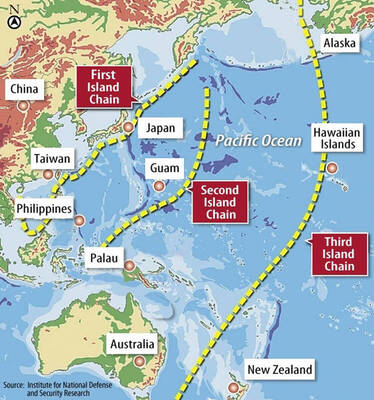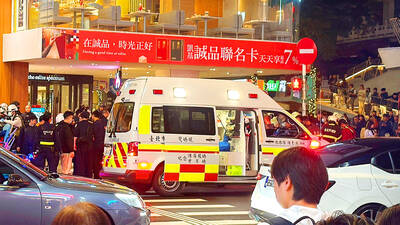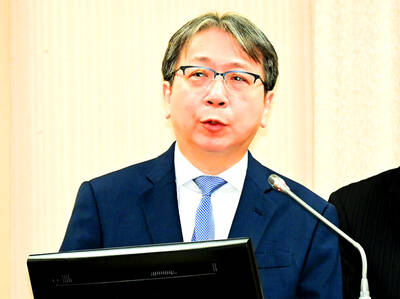The first of the newly completed passenger cars for the Taiwan High Speed Railway were unveiled to the public yesterday morning in Kobe.
"The inauguration of the high-speed railway will be the nation's second transportation revolution, following the completion of the first national freeway," said Minister of Transportation and Communications Lin Ling-san (
The 700T-model railway cars -- manufactured by Taiwan Shinkansen Corp, a joint venture between Kawasaki Heavy Industries and other Japanese companies -- were exhibited yesterday during a roll-out ceremony that began with the playing of the national anthems of the Republic of China (ROC) and Japan.

PHOTO: JOY SU, TAIPEI TIMES
"It's been a long time since the ROC flag was flown in a public arena in Japan. Seeing the flags of both nations flown today at the roll-out ceremony, as well as hearing both national anthems, I am very moved and proud," Lin said.
Lin also said he hoped that the future would afford more opportunities for cooperation and that the friendship between the two nations could reach a point of stability.
"Forty years ago, Japan completed its first high-speed railway line. Today, the Taiwan High Speed Railway 700T cars have become the first international output for the Japanese high-speed railway system. For both nations, this achievement carries historic significance," said Nita Ing (
Lin noted that the high-speed railway was already 53 percent complete and that construction of the civil works portion was 93 percent complete.
Lin said the 700T trains incorporated the latest in technology, with the T standing for Taiwan because they were custom made for the Taiwanese market.
The trains, costing NT$100 million per set, differ significantly from their Japanese counterparts. In addition to an exterior specifically designed to withstand Taiwan's hotter, more humid climate, the trains are capable of traveling as fast as 300 kph. Japan's trains can only travel as fast as 285 kph.
Trains on the northern portion of the high-speed rail line will travel at 285kph, but maintain a speed of 300kph between Tai-chung and the south.
Ing also announced another difference -- smoking will not be permitted on the trains.
Each train will accommodate a total of 989 passengers -- 66 in business class and the rest in the standard-class cars.
The color scheme of the standard-class cars is green. Passengers will be seated five abreast, with three on one side of the aisle and two on the other. The cars will be equipped with bathrooms, vending machines and telephone booths.
According to THSRC officials, the trains will be shipped to Taiwan in May and undergo testing in Kaohsiung in September. The railway, a NT$560 billion project, is scheduled to begin operations in October next year.
As for what will happen to the Taiwan Railway Administration after the high-speed rail line goes into operation, Lin assured the media that after the Lunar New Year strike threat, the TRA was very clear as to what its future operations would be.
He said the eastern region would become the TRA's main market.
Lin said the next task was to formulate guidelines to guarantee smooth operations after the high-speed railway is launched.

The US government has signed defense cooperation agreements with Japan and the Philippines to boost the deterrence capabilities of countries in the first island chain, a report by the National Security Bureau (NSB) showed. The main countries on the first island chain include the two nations and Taiwan. The bureau is to present the report at a meeting of the legislature’s Foreign Affairs and National Defense Committee tomorrow. The US military has deployed Typhon missile systems to Japan’s Yamaguchi Prefecture and Zambales province in the Philippines during their joint military exercises. It has also installed NMESIS anti-ship systems in Japan’s Okinawa

‘WIN-WIN’: The Philippines, and central and eastern European countries are important potential drone cooperation partners, Minister of Foreign Affairs Lin Chia-lung said Minister of Foreign Affairs Lin Chia-lung (林佳龍) in an interview published yesterday confirmed that there are joint ventures between Taiwan and Poland in the drone industry. Lin made the remark in an exclusive interview with the Chinese-language Liberty Times (the Taipei Times’ sister paper). The government-backed Taiwan Excellence Drone International Business Opportunities Alliance and the Polish Chamber of Unmanned Systems on Wednesday last week signed a memorandum of understanding in Poland to develop a “non-China” supply chain for drones and work together on key technologies. Asked if Taiwan prioritized Poland among central and eastern European countries in drone collaboration, Lin

TRAGEDY STRIKES TAIPEI: The suspect died after falling off a building after he threw smoke grenades into Taipei Main Station and went on a killing spree in Zhongshan A 27-year-old suspect allegedly threw smoke grenades in Taipei Main Station and then proceeded to Zhongshan MRT Station in a random killing spree that resulted in the death of the suspect and two other civilians, and seven injured, including one in critical condition, as of press time last night. The suspect, identified as a man surnamed Chang Wen (張文), allegedly began the attack at Taipei Main Station, the Taipei Fire Department said, adding that it received a report at 5:24pm that smoke grenades had been thrown in the station. One man in his 50s was rushed to hospital after a cardiac arrest

ON ALERT: Taiwan’s partners would issue warnings if China attempted to use Interpol to target Taiwanese, and the global body has mechanisms to prevent it, an official said China has stationed two to four people specializing in Taiwan affairs at its embassies in several democratic countries to monitor and harass Taiwanese, actions that the host nations would not tolerate, National Security Bureau (NSB) Director-General Tsai Ming-yen (蔡明彥) said yesterday. Tsai made the comments at a meeting of the legislature’s Foreign Affairs and National Defense Committee, which asked him and Minister of National Defense Wellington Koo (顧立雄) to report on potential conflicts in the Taiwan Strait and military preparedness. Democratic Progressive Party (DPP) Legislator Michelle Lin (林楚茵) expressed concern that Beijing has posted personnel from China’s Taiwan Affairs Office to its